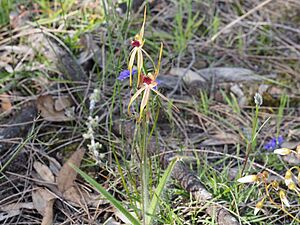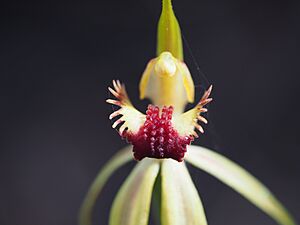Clubbed spider orchid facts for kids
Quick facts for kids Clubbed spider orchid |
|
|---|---|
 |
|
| Caladenia longiclavata growing near Williams | |
| Scientific classification | |
| Genus: |
Caladenia
|
| Species: |
longiclavata
|
| Synonyms | |
|
|
The Caladenia longiclavata, also known as the clubbed spider orchid, is a unique plant. It is part of the orchid family, called Orchidaceae. This special orchid grows only in the south-west area of Western Australia. It is a common flower found in many places. You can see it between the cities of Perth and Albany. It has a single, hairy leaf and usually one or two flowers. These flowers are often greenish-yellow, white, and red.
What Does It Look Like?
The clubbed spider orchid is a perennial plant. This means it lives for more than two years. It grows from an underground tuber, which is like a small storage root. The plant is also deciduous, meaning its leaves fall off at certain times. It has one hairy leaf that is about 90 to 180 mm (3.5 to 7 inches) long. This leaf is only about 2 mm (0.08 inches) wide.
One or two flowers grow on a stem that stands 200 to 350 mm (8 to 14 inches) tall. Each flower is about 50 to 70 mm (2 to 3 inches) long and 40 to 50 mm (1.6 to 2 inches) wide. The flowers have special parts called sepals and petals. These parts have flattened, club-like tips. These tips are yellowish-brown and are 5 to 20 mm (0.2 to 0.8 inches) long.
The top sepal, called the dorsal sepal, stands straight up. It is about 25 to 45 mm (1 to 1.8 inches) long. The two side sepals, called lateral sepals, point stiffly downwards. They are almost parallel to each other. The petals are a bit shorter and narrower than the sepals. They also curve stiffly downwards.
The most interesting part is the labellum. This is the orchid's special lip. It is 13 to 18 mm (0.5 to 0.7 inches) long. The labellum is yellowish with a dark red tip that curls underneath. Its edges have small, narrow teeth up to 3 mm (0.1 inches) long. There are also many rows of deep red bumps, called calli, along its center. These calli are up to 2 mm (0.08 inches) long. This orchid usually flowers from September to early November.
How It Got Its Name
The Caladenia longiclavata was first officially described in 1930. This was done by a person named Edith Coleman. Her description was published in a magazine called The Victorian Naturalist.
The second part of its scientific name, longiclavata, comes from two Latin words. Longus means "long," and clavus means "club" or "cudgel." This name was chosen because of the club-like tips on the sepals and petals of the flower.
Where It Lives
The clubbed spider orchid is very common and can be found in many places. It grows between Perth and Albany in Western Australia. You can find it in different natural areas, including woodlands and forests. These areas are part of what scientists call biogeographic regions. Some of these regions include the Avon Wheatbelt, Esperance Plains, Jarrah Forest, Swan Coastal Plain, and Warren.
Is It Protected?
Good news! The Caladenia longiclavata is not considered to be in danger. The Western Australian Government's Department of Parks and Wildlife has classified it as "not threatened." This means there are plenty of these beautiful orchids in the wild.



